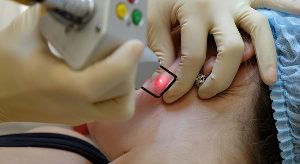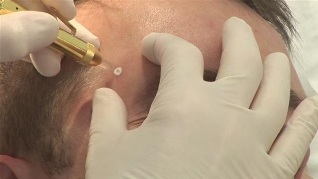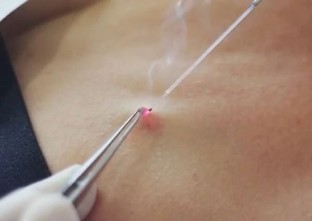
Laser removal of neoplasms is a very common and effective procedure to help get rid of unwanted growth. This is a relatively new method that did not appear in the medical arsenal so long ago, but has already been able to prove its advantage over other methods of removal. Precursors of laser destruction were removed with liquid nitrogen, electricity, or a scalpel. All of this can cause significant discomfort to the patient, while laser removal with painless intervention shows high results.
Why remove
Papillomas, which are growths of various shapes and sizes, are usually benign tumors. They are localized on the wearer's mucosa or skin. The main reason for their appearance is the effect of human papillomavirus, which in most cases is sexually transmitted.
Removing these structures performs multiple tasks at once:
- Aesthetic correction.A growing patient can be uncomfortable if others pay too much attention to them. Because of this, one can feel insecure and uncomfortable, even if growth does not pose a threat to it.
- Prevention of injury.If the growth is in a traumatic location where the patient is constantly touching it, this can lead to splitting of the protruding part. In addition, covering the papilloma with clothing can cause problems such as rubbing the affected area. This is fraught with damage to the papilloma and possible subsequent infection. Damage can lead to the penetration of microbes, which can cause inflammation in the wound. If this happens, the affected area should be treated with peroxide and you should go to the clinic immediately to remove the rest of your papilloma.
- Reduces the risk of cancer.Although the growths are benign, their manifestations are as diverse as warts. They are usually located in intimate places and pose a high risk of developing cancer. All warts should be removed to prevent disease.
Do not remove the accumulation alone. Attempts to tie the papilloma with yarn, combing, or some chemical agent can worsen your condition.
Benefits of the procedure
Laser destruction has several advantages over other methods of removal.These are:
- Guaranteed results.Thanks to the effect of the laser, growth is completely stopped, even in the deep subcutaneous layers. The device is able to penetrate deep enough to clear all traces of the presence of a neoplasm.
- Pain relief.Laser exposure causes minimal pain to the patient. If you use pre-anesthesia with local anesthetics for the procedure, there is no pain at all.
- Speed of the procedure. Laser removal of papillomas requires 2 to 5 minutes per item.
- Non-invasive.The laser beam is in a strictly limited area and does not exceed it. In this case, more than one part of the laser does not affect the location of the procedure. This is very important as this method helps to minimize the risk of infection and provides a high guarantee of sterility.
- No postoperative scar.If the work is done correctly, there should be no trace of laser operation at the point of exposure. This is due to the fact that the affected tissue completely evaporates and is then replaced by new, intact skin.
- Bloodless wipe mode.The laser beam heats up the blood-supplying capillaries, quickly closing their villages. As a result, the bleeding stops and does not continue after surgery.
- Suitable for different parts of the body.Not all removal methods can be applied to all parts of the body. Intimate areas, eyelids, etc. are considered particularly sensitive. Thanks to the accuracy of the laser beam, the laser beam does a good job of handling the growth in these areas.
All of these factors make laser removal one of the most popular methods to get rid of growth.
Contraindications
The contraindications to this procedure are not as long as other methods of destruction.Between laser removal bans:
- diabetes mellitus;
- oncology;
- exacerbation of chronic diseases;
- epilepsy;
- diseases associated with endocrine problems;
- poor blood clotting;
- HIV or AIDS;
- acute inflammatory diseases.
In addition, patients who have recently had the flu or an acute respiratory infection should also postpone the procedure for a while.
Description of the procedure
Before beginning any procedure to remove growths, your doctor will disinfect the area you want to have surgery on. In some cases, a local anesthetic is used. Ointments or sprays are usually used for this purpose. It takes 2-3 minutes after using the anesthetic drug and the removal process begins.

The laser beam is aimed at the affected area and is about to soak up unwanted growth. At this point, the contents of the cells evaporate under the influence of the laser, removing each layer of affected tissue. This is not just happening in easily accessible places in open spaces. The procedure for removing the papilloma, such as on the eyelid, is the same. The only nuance in this area is that a special cooling method is used for the patient to prevent pain and burns at this sensitive point.
Tumors in intimate areas can be removed according to the same principle. But here the doctor usually uses an anesthetic injection as an anesthetic, injecting the growth from different sides.
The moment the needle is inserted can be a little painful, but after a few minutes the sensitivity in the affected area disappears completely and further manipulations are completely painless.
The affected area becomes a small wound without blood. At the time of destruction, it is disinfected due to the work of the laser. After removing the buildup, the doctor will treat the affected area with potassium permanganate.
After the procedure, the patient may experience mild redness, itching, or mild pain at the site of papilloma removal.
This reaction is considered normal because, although the procedure is not invasive, there was an interference with skin integrity during surgery.All discomfort will disappear completely 2-4 days after the procedure.
Dry crust appears later over the wound. Beneath it is an already healthy layer of skin, so its protective shell cannot tear until it falls off on its own. Otherwise, a scar may remain on the skin and the healing process itself may take longer.
Consequences
Complications after laser destruction are rare. Usually, their presence is associated with diseases that the patient already has that they did not cure before the procedure. Thus, for example, if a patient has had dermatitis, this may contribute to the appearance of pigmentation. If the skin itself is very sensitive, mild redness can cause burns. In case of a high allergic reaction, edema may occur at the site of exposure.
To avoid any undesirable consequences, consult a doctor before laser destruction.
Post-procedure care
After removing the buildup, the patient should follow these rules:
- Do not allow water to enter the wound for 2-3 days;
- refrain from visiting saunas, spas and swimming pools;
- do not rub the damaged area with a towel;
- Do not use an adhesive patch on the wound;
- Do not treat the papilloma removal site with scrubs or body lotions containing alcohol;
- Avoid exposure to ultraviolet radiation.
Wound antiseptic treatment should be performed several times a day. This should be done by the time the scab is separated. This treatment prevents infection and helps speed up the time to complete recovery.You can take iodine or potassium permanganate solution to treat the affected area.
After removal, can be treated with anti-inflammatory ointments.
Their effect is to accelerate tissue regeneration, relieve inflammation and edema. It is best to consult a doctor before choosing a specific treatment.
Which method is better
Laser removal is not the only way to treat unwanted growth. There are other ways to stand out:

Cryodestruction.
Based on removal of papillomas with liquid nitrogen. Due to exposure to low temperatures, the deposits begin to collapse and eventually disappear completely. The method is effective, but it has several drawbacks. Among them, the impossibility of complete control of the depth of action of nitrogen. The substance can penetrate very deeply, touch a healthy area, or vice versa, act only superficially without affecting all layers of localization of accumulation.
In addition, this method is characterized by the following:
- the possibility of postoperative scars;
- painful feelings;
- is unable to guarantee the result after the first procedure.
Thus, laser destruction is more efficient than cryodestruction. Laser removal is less painful and more likely to guarantee the desired result.
Removes radio waves.
This method of destruction is performed using special equipment that acts on the papilloma through radio waves. This contributes to cutting out the accumulation due to the point effect of the radio knife. The accuracy of the procedure is very high, so it does not affect adjacent tissues. However, the risk of burns or infections is extremely low.
This method is suitable for removing small benign lesions. It is very effective, which makes it as popular as laser destruction. Both methods are considered a modern approach to the removal of papillomas and are equally well applied in medicine.

Electrocoagulation.
This method is based on the action of a high-frequency electric current that acts on the papilloma directly at the site of injury. Electrocoagulation is now considered a common but obsolete method. This method makes it possible to prevent bleeding after removing the papilloma by burning the vessels.
However, when using high-frequency current, patients experience pain that persists after anesthesia. This causes some patients to abandon the electrocautery, opting for laser removal as a more advanced and painless method.
Estimated cost
The price range depends not only on the region and clinic where the removal is performed, but also on the number, size, and location of the removed growths.
Many clinics have discounts for mass removal of new tumors: the more patients there are, the cheaper it will be to remove a growth.
Getting rid of genital growth can be significantly more expensive than getting to other parts of the body. Moreover, due to the complexity of such manipulation, not all clinics provide such a service.















































































